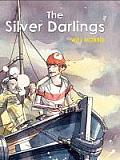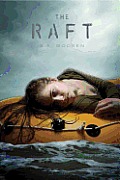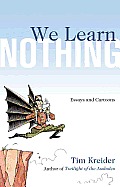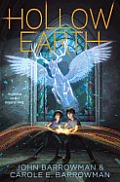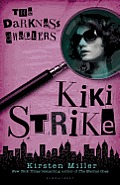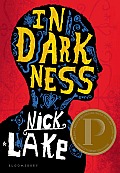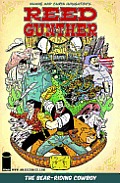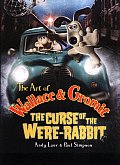Link to this review in the form of a comic strip by geneambaum tagged coming of age • graphic novel
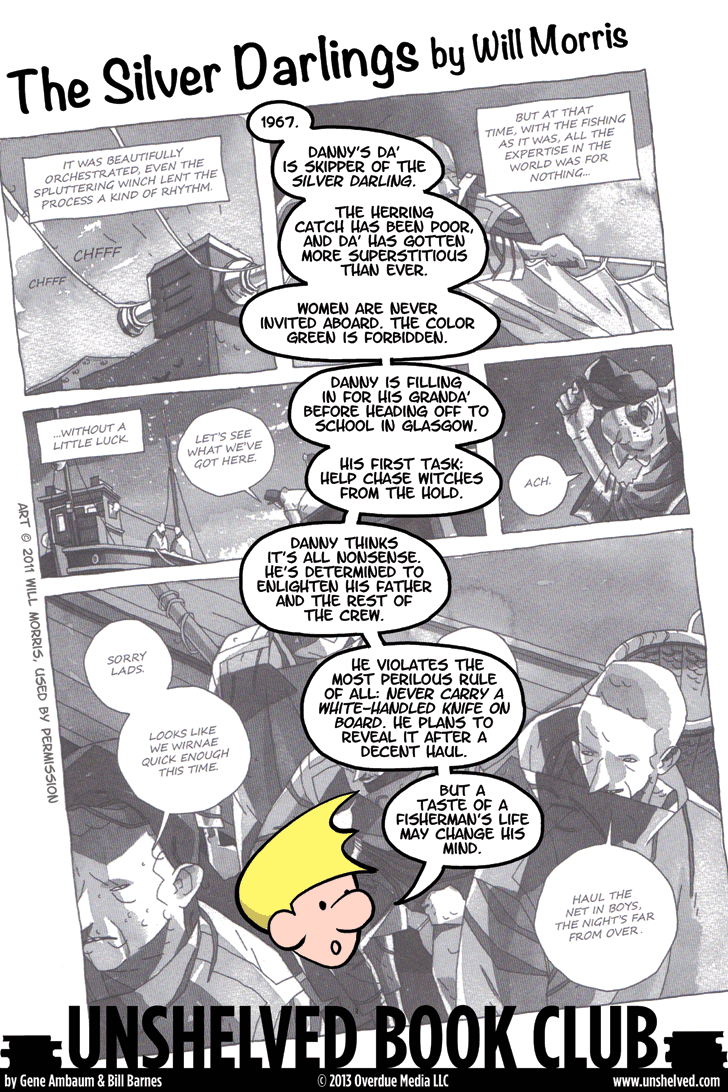
Click for the full-sized comic
@bookblurb Will is determined to rid his father of fishermen’s superstitions during his time on board the Silver Darling.
Link to this review by danritchie tagged thriller
Fifteen-year-old Robie lives on Midway Island in the Pacific. Her parents are marine biologists involved with the national wildlife preserve. Being the only child on the island, her life is hardly normal. There’s no TV, intermittent Internet at best, and her only friends are adults. Every few months, her folks send her to Honolulu on the supply plane to stay with her aunt A.J. They shop, hang by the pool, and explore the city.
But on the way home after an eventful trip, a storm forces Robie’s plane to ditch into the Pacific Ocean. She manages to get into a raft but she has no food, no water, and little chance of being found.
Why I picked it up: The author’s last book, The Gardener, is one of my all-time favorites.
Why I finished it: Robie’s struggle to figure out how to survive. She has been well-schooled on marine life by her parents; her knowledge is both comforting and terrifying, especially when her raft is surrounded by aggressive tiger sharks that she knows will eat anything (including her). She vacillates between hopelessness and moments of McGiveresque creativity, like when she fashions a fishing line from her hoodie tie and a piece of spiral notebook wire. The plane’s other survivor sleeps almost all the time, but she talks to him to help keep despair and sense of futility at bay.
I’d give it to: Dani, who loved Gary Paulsen’s Hatchet. She will enjoy the gritty details of Robie’s mistakes and setbacks, like when she drops her flashlight overboard and wastes her flares. But she’ll also cheer at Robie’s small victories, which keep her alive: figuring out how to patch the leaky raft and catch rainwater.
@bookblurb After Robbie’s plane crashes into the Pacific, she has to survive without food, water, or much chance of being found.
Link to this review by geneambaum tagged essays • comic strips • nonfiction • humor
Previously published personal essays and cartoons (most of which were created for this collection) by NY Times columnist Tim Kreider.
Why I picked it up: I heard Kreider talk about what he learned about a friend named Skelly after he died on Radiolab. Then, a week later, I heard him tell the story of being stabbed in the throat on This American Life. (Both stories are in this book.) After hearing these, I realized why his name was familiar: he drew my favorite, completely indefensible, entirely not-safe-for-work, one-panel comic. (If you look, make sure you read the artist’s statement below the comics — it made me enjoy this one even more.)
Why I finished it: Kreider is at his best when he’s writing about friends and family. His buddy, Skelly, lied a lot. Everyone who loved him focused on his personality and the fun of hanging out with him. But Kreider clearly feels a bit of guilt over the fact that this led to ignoring Skelly’s deeper problems, too. Kreider also talks about his difficulties over a friend breaking up with him. He doesn’t and never will know the reasons. And then he writes a friendship-ending essay about another man whose conclusions about peak oil drove him and Kreider apart.
I was nodding along and then, near the end of the book, I found the essay that spoke most personally to me, “Sister World,” about his weird, close relationship with his half-sisters whom he met for the first time as an adult. (I have a newish sister, too.)
I’d give it to: Rachel, who keeps reenlisting in a bad relationship. I hope she’ll see herself in “The Creature Walks Among Us,” Kreider’s essay on heartbreak and the sorts of things it pushes us all to do. He starts it with the tale of the jilted astronaut who may or may not have driven cross country wearing a diaper as part of a revenge/get-the-guy-back plot. He ends his opening with a line that made me giggle: “We’ve all worn the diaper.”
@bookblurb Columnist and cartoonist Tim Kreider’s funny, moving essays and comics about family, friends, and relationships.
Link to this review by snow tagged fantasy • paranormal • art
Twins Matt and Em Calder have special powers — they can talk telepathically to each other and can make their drawings come to life. Right after they discover that they can also enter paintings, their powers put them and their mother in grave danger. Hiding out at their grandfather’s house on a remote Scottish island, Matt and Em are soon caught between those who want to lock away their powers forever and the Hollow Earth Society, whose members want to use the twins to unleash the monsters living inside the world below ours.
Why I picked it up: I’m a Doctor Who fangirl, and I picked it up because it was written by John Barrowman, who played the immortal Captain Jack Harkness on that show and its spin-off, Torchwood.
Why I finished it: Because it was a fun fantasy/adventure with a fine art theme. The Barrowmans are especially skilled at making art sound interesting without making the story into an educational lesson. I chuckled when, after the twins decided that a hot day called for a cooling swim, they went for one inside Georges Seurat’s Bathers at Asnières.
Caught in that middle ground between childhood and adolescence, the twins were believably bratty, resourceful, funny, and caring by turns. I especially liked that instead of their powers being a sudden revelation (everyone already knows about them), the unrealized importance of those powers was the focus of the story.
I’d give it to: Bran. Even though he doesn’t get along with his sister as well as Matt gets along with Em, he’ll enjoy both the book and the interactive resources available on the Hollow Earth website, including information about the paintings, a guide to British sign language, and drawing pages to encourage doodling.
@bookblurb Telepathic twins vs. the Hollow Earth Society, who want to release the monsters from the world below ours.
Link to this review by flemtastic tagged nonfiction
Tim Grover was a decent college basketball player who suffered several debilitating injuries that made a pro career a non-starter. Driven to excel in something sports-related, he chose to become a trainer for professional athletes. Despite not having earned a reputation at that point, he managed to get an interview with basketball great Michael Jordan. Jordan was dubious about Grover’s pitch about a gradual strengthening regimen to prevent injury, but granted him a trial period. That turned into a fifteen-year collaboration which made Grover’s name. Since then, he has worked with hundreds of other top-level athletes, honing their athletic skills, bodies, and minds.
Grover believes athletes need to focus on taking charge, doing what is necessary to achieve victory, and own the results. He refers to those who do this as Cleaners; they have the confidence to solve any problem through hard work and trust in their talents. Grove believes this mindset can be useful in any business or endeavor, not just sports. There are thirteen principles that make up his philosophy, and he gives each its own chapter, with anecdotes and examples of how people have used them to achieve success. Grover is unapologetic about advocating a ruthless, relentless focus on greatness, even if this comes at the cost of personal relationships. He says that we can only choose to be truly great at one thing, and to do so one must crave success so intently that the amount of work to achieve it doesn’t matter.
Why I picked it up: I have heard Tim Grover’s name for decades, since he began working with Michael Jordan. I wanted to see what he had to say about excellence and whether this kind of information could be useful to a balding, forty-two-year-old man who loves basketball.
Why I finished it: Grover peppers his book with anecdotes of working with world-class, well-known athletes about bringing them back from injuries, preparing them for the playoffs, and even dismissing them from his gym for not participating fully in his program. He talks about Bill Russell contemplating his uniform number of thirteen, which some would consider unlucky. (Bill put in the work and went on to eleven NBA championships; he considered the number unlucky to his opponents, not himself.) Lastly, Grover argues that to be great one must access his/her dark side to bring forth the ruthlessness and single-mindedness necessary to excel.
I’d give it to: My three sons, because they would love the inside information about how Grover brought Dwyane Wade back from injury to help the Miami Heat win the championship last year.
@bookblurb Tim Grover trains pro athletes to excel, and believes his philosophy is applicable to any endeavor.
Link to this review by gigi tagged mystery • coming of age
(WARNING: Contains spoilers for the first two books.)
Kiki tries to go to Pokrovia (her home country) to tell everyone that her aunt killed her parents. But on the way she gets kidnapped by her aunt and cousin and stuck in a bell tower.
Back in New York, the Irregulars have their own problems. Oona Wong’s twin sister is stealing and leaving restaurants without paying (people think she’s Oona). Someone is stalking Deedee. Ananka needs to arrange things so that Betty can get Luz’s hair-growing serum to Kiki (so that she can use it as a bargaining chip).
Why I picked it up: I loved the first two books in the series, In the Shadow City and The Empress’s Tomb.
Why I finished it: Kiki is super tough, but in the tower where she’s held prisoner, she has to wear a pink dress. It’s the only thing she has that will keep her warm, but she hates pink. (I kind of hate pink, too, so it made me laugh.)
I’d give it to: My friend Colette, who wants to be a fashion designer, because Betty (another of the Irregulars) is a master of disguise, and she wears all different kinds of weird clothes so people don’t recognize her.
@bookblurb Kiki Strike has been kidnapped, Oona Wong’s sister is impersonating her, and someone is stalking Deedee.
Link to this review by dawnrutherford tagged coming of age • thriller • literary
After devastating earthquakes in Haiti, a teenage boy, Shorty, recovering from a bullet wound, is trapped in a small space under the ruins of a hospital. Starving and thirsty, he is surrounded by seemingly endless darkness, but he can also feel blood and the hand of a body pinned under the rubble.
Why I picked it up: This has been to on my to-read list for a while, but I put off reading it because I thought it looked depressing. But when it won the Printz, I decided to finally see what I had been missing.
Why I finished it: I’ve read a lot of articles about what a wreck Haiti has become, and how the humanitarian aid often seems to make as many messes as it helps, but I never had a grasp on what it’s like to be there. In Darkness is a brilliant piece of storytelling that mixes historical fiction, urban gang life, and folklore/religion to create a setting that goes beyond facts to illustrate the heart of the place. As Shorty weakens, he is forced to drink his own blood and tears. Awake, he looks back on why he joined a gang and became a gunman in an effort to get his twin sister back. Asleep, he enters the life of Toussaint l’Ouverture, witnesses the revolution that freed the slaves in Haiti, and discovers hope.
I’d give it to: Chantrelle. While she lived in Grenada, she made it a point to learn about the local culture. (She taught me the pleasure of traveling in minibuses.) I know she’d love how the characters transcend stereotypes — Shorty, Biggie and their friends seem like many other violence-prone, inner-city gangsters at first, but their weaknesses and motivations reveal their humanity.
@bookblurb A teenage boy is trapped beneath the rubble of a hospital after an earthquake in Haiti.
Link to this review by geneambaum tagged humor • graphic novel • western
Reed Gunther and his bear, Sterling, meet Starla when she finds them on her ranch and mistakes them for cattle rustlers. After they help her with her cows by taking on a giant rattlesnake, Reed unintentionally begins waking up monsters as he travels across the country.
Contains Reed Gunther #1 - #5.
Why I picked it up: I read the first issue on Free Comic Book Day.
Why I finished it: Chris Houghton’s art conveys a complete array of emotions in simply drawn, cartoonish characters, both human and non-. And since Unshelved went color in October, I’ve been paying more attention to the textures and color gradients used — Houghton and Ciaran Lucas do a spectacular job using both to add to the story without distracting from it.
I’d give it to: My brother-in-law Ray, who would identify with the “cowboy in the big city” moment at the end of the book, when Reed and Sterling go to New York to confront the villains, who have been gathering the monsters for a freak show.
@bookblurb A cowboy and his bear help defeat a giant rattlesnake and then accidentally awaken monsters across the country.
Link to this review by flemtastic tagged nonfiction • coffee table book • art
Andy Lane and Paul Simpson were given full access to Aardman Studios while the studio was conceiving and creating The Curse of the Were-Rabbit. The studio is a giant warehouse with hundreds of dedicated craftsmen and women who bring every aspect of Wallace and Gromit’s town to life in stunning detail. The animators go to great lengths to bring verisimilitude to their films. For instance, they used the actual sound of a horn from an Austin A35 in the film and also made a small clay copy for a chase scene. Color photographs show every step of the design team’s plan, from early pencil sketches to wire molds, from each character’s plasticine lips to city blocks the animators tower over like Godzilla attacking Tokyo.
Why I picked it up: I’ve been a huge fan ever since I saw the first three Wallace and Gromit films (A Grand Day Out, The Wrong Trousers, A Close Shave).
Why I finished it: I learned some pretty cool tidbits about animating Wallace. Because of his large noggin and ears, he cannot be shot from certain angles or he’ll look “like an old potato.” Inside, he and other characters have wire undercarriages that can be moved into hundreds of positions. Plasticine was used in the early films and for much of The Curse, but the designers also used a foam that could be molded more quickly in some shots.
I’d give it to: Robb, who paints Dungeons and Dragons figurines as a hobby. While the subject matter couldn’t be any more different, Robb would love seeing how the animators achieve this amazing level of detail in their work. He might even pick up some useful techniques, like the three washes and glazes Aardman artists used to make the cobblestone streets in Wallace’s town look properly wet and decrepit.
@bookblurb A behind-the-scenes look at the art and making of The Curse of the Were-Rabbit.
